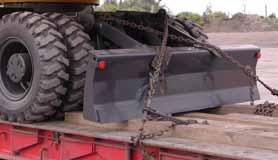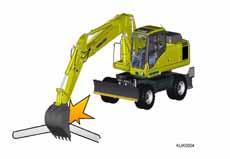
4 minute read
COLD WEATHER OPERATION
PRECAUTIONS FOR LOW TEMPERATURE
If the temperature becomes low, it becomes difficult to start the engine, and the coolant may freeze, so do as follows.
FUEL AND LUBRICANTS
Change to fuel and oil with low viscosity for all components. For details of the specified viscosity.
For details, see "USE FUEL, COOLANT AND LUBRICANTS ACCORDING TO AMBIENT TEMPERATURE (230)"
WARNING
Antifreeze is toxic. Be careful not to get it into your eyes or on your skin. If it should get into your eyes or on your skin, wash it off with large quantities of fresh water and see a doctor at once.
Antifreeze is toxic. Be extremely careful when handling it. When replacing coolant containing antifreeze or when handling coolant when repairing the radiator, contact your Komatsu distributor or ask your local antifreeze dealer. Be careful not to let the water flow into drainage ditches or spray on to the ground surface.
Antifreeze is flammable, so do not bring any flame close. Do not smoke when handling antifreeze.
NOTICE
● Never use methanol, ethanol or propanol based anti
freeze.
Absolutely avoid using any water leak preventing agent, weather it is used independently or mixed with an antifreeze.
Do not mix one antifreeze with a different brand.
For details of the antifreeze mixture when changing the coolant, see "CLEAN INSIDE OF COOLING SYSTEM (250)".
REMARK
Where no permanent antifreeze is available, an ethylene glycol antifreeze without corrosion inhibitor may be used only for the cold season. In this case, clean the cooling system twice a year (in spring and autumn). When refilling the cooling system, add antifreeze in autumn, but do not add any in spring.
For details of the antifreeze mixture when changing the coolant, see "CLEAN INSIDE OF COOLING SYSTEM (250)".
BATTERY
WARNING
The battery generates flammable gas, so do not bring fire or sparks near the battery.
Battery electrolyte is dangerous. If it gets in your eyes or on your skin, wash it off with large amounts of water, and consult a doctor.
Battery electrolyte dissolves paint. If it gets on to the bodywork, wash it off immediately with water.
If the battery electrolyte is frozen, do not charge the battery or start the engine with a different power source. There is danger that the battery may explode.
When the ambient temperature drops, the capacity of the battery will also drop. If the battery charge ratio is low, the battery electrolyte may freeze. Maintain the battery charge as close as possible to 100%, and insulate it against cold temperature so that the machine can be started easily the next morning.
REMARK
Measure the specific gravity and calculate the rate of charge from the following conversion table.
Temperature of fluid
Rate of charge 20ºC 0ºC -10ºC -20ºC
100 1.28 1.29 1.30 1.31
90 1.26 1.27 1.28 1.29
80 1.24 1.25 1.26 1.27
75 1.23 1.24 1.25 1.26
Because the battery capacity drops markedly in low temperatures, cover the battery or remove it from the machine. Keep it in a warm place overnight, and install it again the next morning.
If the electrolyte level is low, add distilled water in the morning before beginning work. To prevent fluid in the battery from freezing in the night, do not add the water after the day's work.
PRECAUTIONS AFTER COMPLETION OF WORK
WARNING
After completion of operations, fill the fuel tank to prevent the formation of water caused by condensation of moisture in the empty space in the tank when the temperature goes down.
To prevent mud, water, or the undercarriage from freezing and making it impossible for the machine to move the following morning, always observe the following precautions.
Mud and water on the machine body should be completely removed. This is to prevent damage to the seal caused by mud or dirt getting inside the seal with frozen drops of water.
Park the machine on hard, dry ground. If this is impossible, park the machine on wooden boards. The boards help protect the wheels from being frozen in soil and the machine can start next morning.
Open the drain valve and drain any water collected in the fuel system to prevent it from freezing.
After operation in water or mud, remove water from undercarriage to extend undercarriage service life.
AFTER COLD WEATHER
When season changes and the weather becomes warmer, do as follows.
Replace the fuel and oil for all parts with oil of the viscosity specified.
For details, see "USE FUEL, COOLANT AND LUBRICANTS ACCORDING TO AMBIENT TEMPERATURE (230)"
If for any reason permanent antifreeze cannot be used, and an ethyl glycol base antifreeze (winter, one season type) is used instead, or if no antifreeze is used, drain the cooling system completely, then clean out the inside of the cooling system thoroughly, and fill with fresh water.





